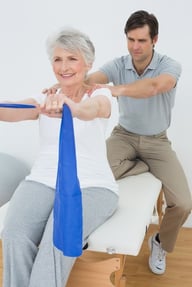 About half of all women in the U.S. and a quarter of all men will be diagnosed with osteoporosis. Some will be diagnosed through bone density screening tests, while others will find out after suffering a serious bone fracture. Hearing that you have osteoporosis is never a pleasant experience. However, the good news is that bone strength and density can be improved with osteoporosis treatment, slowing progression of the disease, and lifestyle changes and exercise can help as well.
About half of all women in the U.S. and a quarter of all men will be diagnosed with osteoporosis. Some will be diagnosed through bone density screening tests, while others will find out after suffering a serious bone fracture. Hearing that you have osteoporosis is never a pleasant experience. However, the good news is that bone strength and density can be improved with osteoporosis treatment, slowing progression of the disease, and lifestyle changes and exercise can help as well.
About Osteoporosis
Osteoporosis happens when the mesh-like structure within the bones thins, causing bones to become fragile, breaking easily. Known as fragility fractures, these breaks can happen anywhere in the body, but are most common in the wrists, hips, and spine. Other common affects of the disease are loss of height and curvature of the spine, as weakened bones in the spine are broken or compressed.
Once you have osteoporosis, reversing the disease completely is not possible. However, it is possible to slow its progression, and, in many cases, improve the strength and density of bones, reducing the severity of osteoporosis and preventing some of its more harmful effects. Of course, regular medical care is essential to that goal, including medications that help maintain and/or improve bone density. Along with that care, your doctor will recommend lifestyle changes and exercise to aid in osteoporosis treatment and management.
How Lifestyle Changes and Exercise Can Help
Making changes in your lifestyle can go a long ways towards improving bone health. Perhaps most important is to increase your intake of calcium and vitamin D, which are essential building blocks for the development and maintenance of healthy bone tissue. Adults over age 50 need 1,200 mg of calcium and 800 IU of vitamin D daily to promote bone health.
Calcium rich foods that you can add to your diet to meet that daily requirement include dairy products, sardines (with bones), dark green vegetables and calcium fortified foods, such as some cereals and fruit juices. Vitamin D is found in vitamin D fortified dairy products, oily fish, like tuna, salmon and mackerel, as well as egg yolks and liver. Supplements are an option to discuss with your doctor as well, especially when it comes to vitamin D, since getting enough of it from dietary sources can be very difficult.
Smoking weakens bones, so if you smoke, quit. If you have not had much luck quitting on your own, ask your doctor about options like nicotine replacement or medications. Excessive use of alcohol and caffeine are also detrimental to bone health, so limiting your intake of beverages that contain them is wise.
Exercise is essential to bone health and osteoporosis treatment. Bones, like muscles, are living tissue that responds to exercise by becoming stronger, the stress it places on the bones stimulating increased production of new bone cells for their repair and maintenance. Exercise also helps maintain muscle strength, balance, and coordination, factors that can reduce risk of falls and fractures in osteoporosis patients. Of course, any new exercise program should be approved by your doctor, and if your osteoporosis is severe, working with a physical therapist is your best bet.
Given today's more effective osteoporosis treatment options and greater knowledge about the disease, an osteoporosis diagnosis does not have to be as devastating as it once was. Taking care of yourself by means of good medical care, healthy lifestyle choices and regular exercise can help improve osteoporosis, slowing its effects on your bones, your lifestyle, and your overall health.





